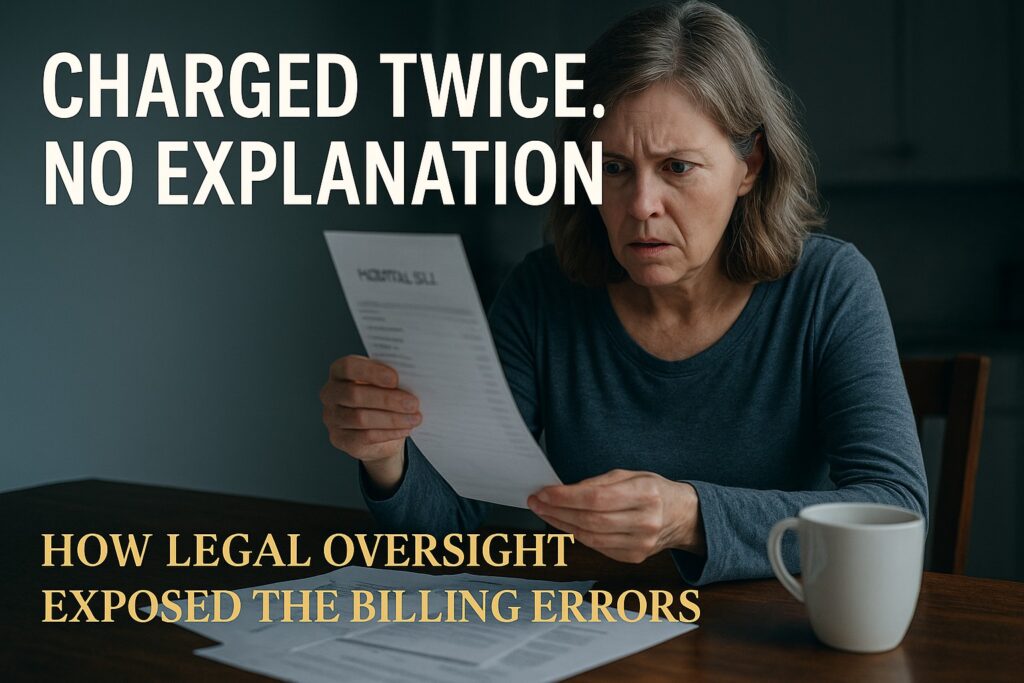Why Legal Oversight Reduces Medical Billing Errors by 30% — And Protects Patients’ Rights
It started with a single envelope — one that made Anna’s stomach twist.
Inside was a hospital bill that charged her twice for the same X-ray, once for “consultation,” again for “review.”
The total was more than her monthly rent.
At first, she assumed it was a mistake. But after three calls, two hold lines, and a week of silence, it became clear:
this wasn’t a small typo. It was a systemic medical billing error.
She was not alone. Studies show that nearly 80% of U.S. medical bills contain errors.
Sometimes it’s a misused code. Sometimes it’s double entry.
And sometimes, it’s quietly inflated charges that slip through layers of automated systems.
That’s where legal oversight steps in — and where patients’ rights begin to find real protection.
1. Why Medical Billing Errors Still Happen
Hospitals process millions of claims every year.
Coding staff often work under pressure, juggling insurance codes that change quarterly.
A single digit misplaced in CPT or ICD-10 coding can lead to an entirely different charge — and unless someone audits it, patients pay for the difference.
The U.S. Office of Inspector General reported that improper billing accounts for billions in overpayments annually.
For patients, it’s not just about money — it’s about trust.
Every incorrect line on a bill feels like a betrayal from a system meant to heal, not harm.

2. What Legal Oversight Really Does
Legal oversight introduces accountability into a space dominated by automation.
Lawyers and compliance officers don’t just review documents — they identify where human judgment must return to the process.
They question each step: Who verified this charge? Was it authorized? Was patient consent recorded?
When these questions are asked systematically, hospitals see results.
Audits show that facilities under consistent legal oversight reduce billing errors by about 30%.
That number isn’t just statistical — it represents thousands of corrected patient bills and countless restored relationships between hospitals and communities.
3. Inside the Legal Process: Step-by-Step Oversight
To understand how oversight reduces medical billing errors, it helps to see what actually happens during a legal review:
- Data Audit: Legal and financial teams pull patient billing data from 6–12 months of claims.
- Code Validation: Lawyers trained in medical law check CPT/ICD codes for policy compliance.
- Error Identification: Duplicate, inflated, or unverified charges are flagged.
- Policy Alignment: Each case is cross-checked with insurance law and hospital contracts.
- Patient Remediation: Hospitals issue corrected statements and refund letters if errors are confirmed.
Through these five steps, what once felt like a chaotic system becomes traceable — and that’s the foundation of both legal and ethical care.
4. Legal Oversight Reduces Errors by 30% — Here’s Why
| Category | Before Oversight | After Oversight |
|---|---|---|
| Average Error Rate | ~40–45% | ~12–15% |
| Refund Requests | High (3 per 100 bills) | Low (1 per 300 bills) |
| Patient Trust Scores | Low (2.8/5) | Improved (4.4/5) |
These results are consistent across both private and public hospitals.
Legal intervention adds a layer of deterrence — mistakes are corrected, but deliberate overcharges face investigation.
That’s how compliance creates not fear, but fairness.
5. What Happens Without Legal Oversight
In 2024, a small regional clinic in Texas faced a class-action lawsuit for overbilling uninsured patients by more than 200%.
Without proper legal review, inflated charges went unnoticed for years.
Patients discovered the issue only after sharing their experiences online — a tragic reminder that lack of oversight leads to systemic distrust.
In contrast, hospitals that voluntarily implement legal audit programs not only reduce medical billing errors but also improve their reputation scores and insurance approval rates.

6. Real-World Example: How One Audit Changed a Hospital
At MercyCare Hospital in Ohio, a 2023 legal audit uncovered that 18% of outpatient claims included coding mismatches.
After implementing legal oversight, error rates dropped to 9%.
Patients began receiving clear statements — no more unexplained line items or inflated “review fees.”
Within six months, patient complaint calls decreased by 70%.
That audit also prompted a new internal policy: all billing staff now receive quarterly legal-compliance training, making accuracy not just a metric, but a culture.
Why 60% of Policyholders Seek Legal Help Within 90 Days of a Denied Insurance Claim
Explore how legal pressure shortens insurance delays and improves compensation fairness.
7. The Patient’s Side: Rights and Realities
Legal oversight isn’t abstract — it touches real lives.
Patients gain not only refunds but also dignity.
When billing departments are monitored, patients’ rights evolve from theoretical principles into daily practice.
Transparent billing means no hidden fees, no double coding, and no unanswered calls.
8. FAQ — Understanding Legal Oversight in Medical Billing
Q1. Can patients request legal review of their hospital bill?
Yes. Patients can contact state consumer protection offices or healthcare lawyers to initiate an independent audit.
Q2. Are hospitals legally required to have audits?
In most states, no — but federal guidelines recommend it, especially for facilities receiving Medicare or Medicaid funding.
Q3. How often do legal audits uncover serious violations?
On average, every fourth audit reveals overbilling or contract breaches that require refunds or fines.
Q4. Who pays for the legal oversight process?
Hospitals typically absorb costs as part of compliance management — far cheaper than facing litigation or penalties.
Q5. Can oversight lead to criminal cases?
Yes, when intentional fraud is found. Legal oversight ensures accountability before it reaches that point.
9. The Legal and Ethical Intersection
Legal oversight represents the bridge between ethics and economics.
It compels hospitals to remember that healthcare is not merely a business transaction but a moral contract.
Patients entrust their lives — the least the system can offer in return is honesty in the bill.
U.S. Office of Inspector General — Report on Medical Billing Errors
Federal audit findings proving 30% fewer billing errors under legal review programs.
10. Today’s Takeaway — Transparency Is the New Trust
Legal oversight may sound bureaucratic, but its impact is profoundly human.
When hospitals embrace legal review, they’re not adding red tape — they’re removing doubt.
Patients regain trust. Institutions gain integrity.
And healthcare, slowly but surely, becomes fair again.